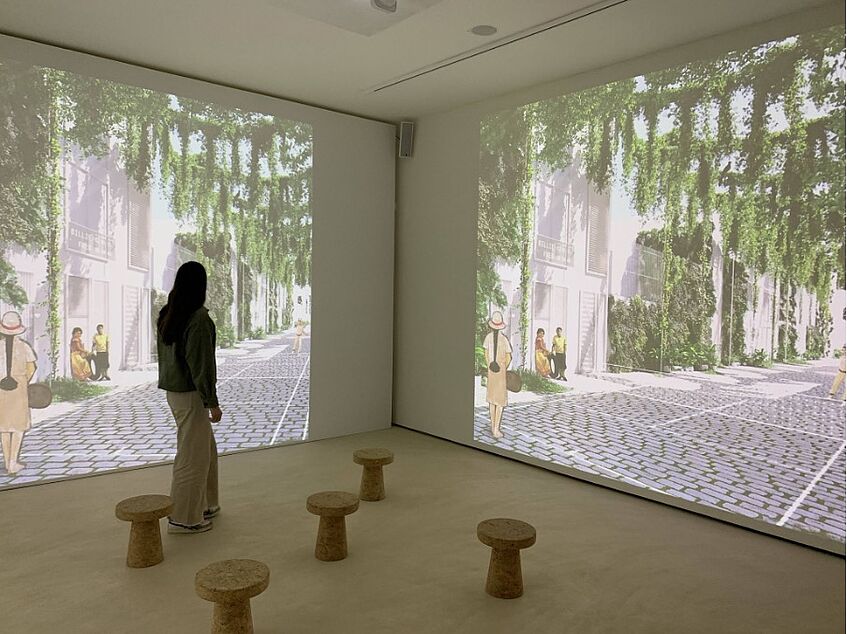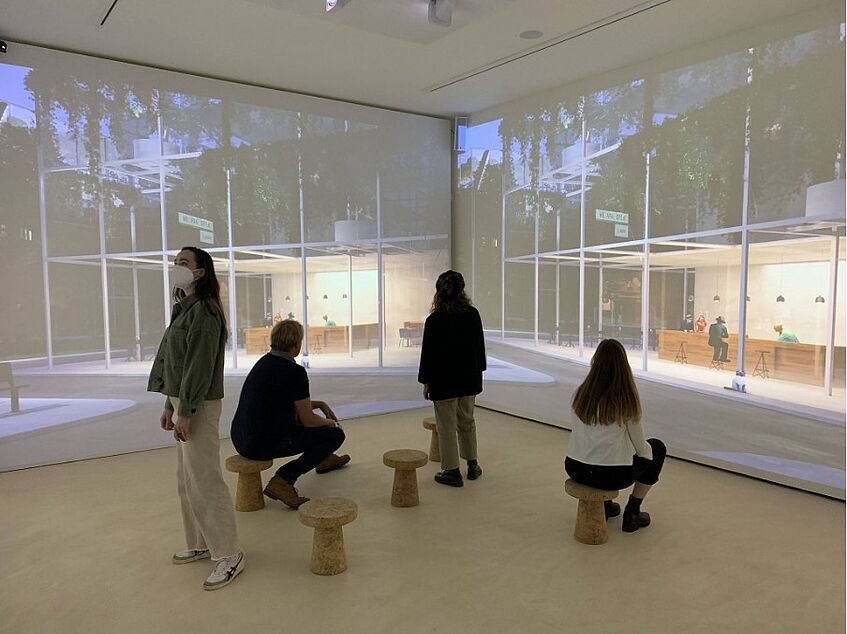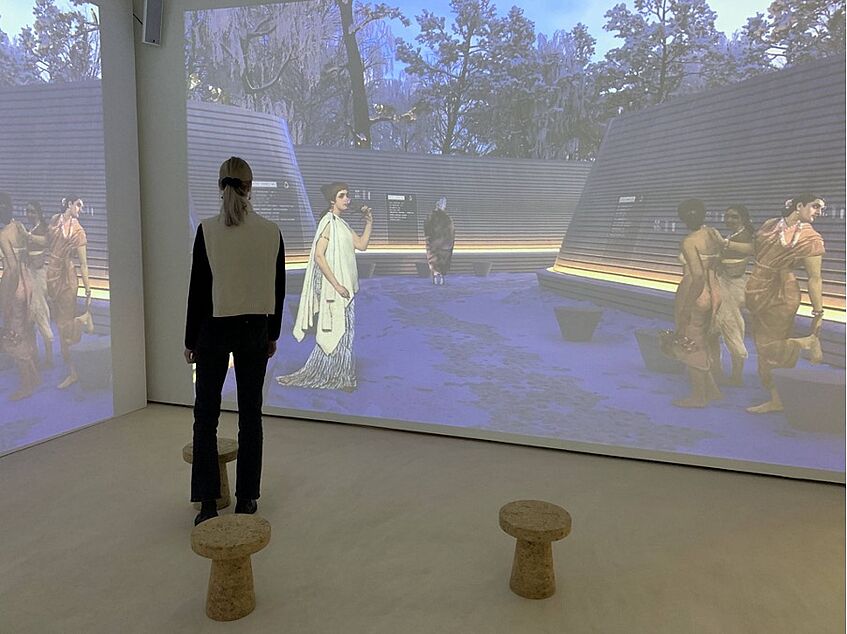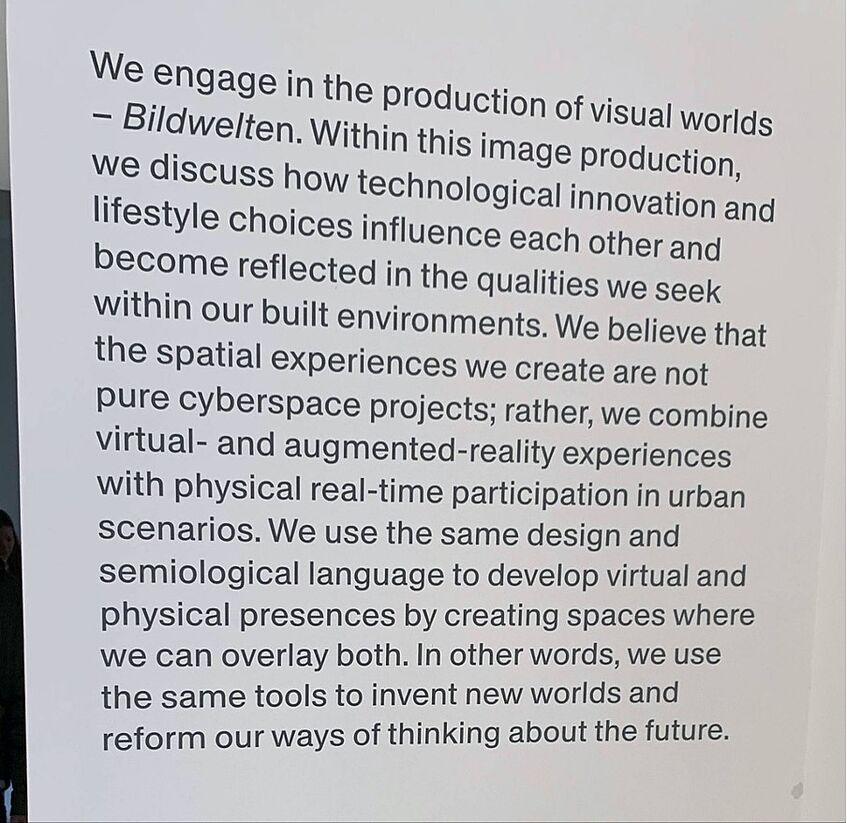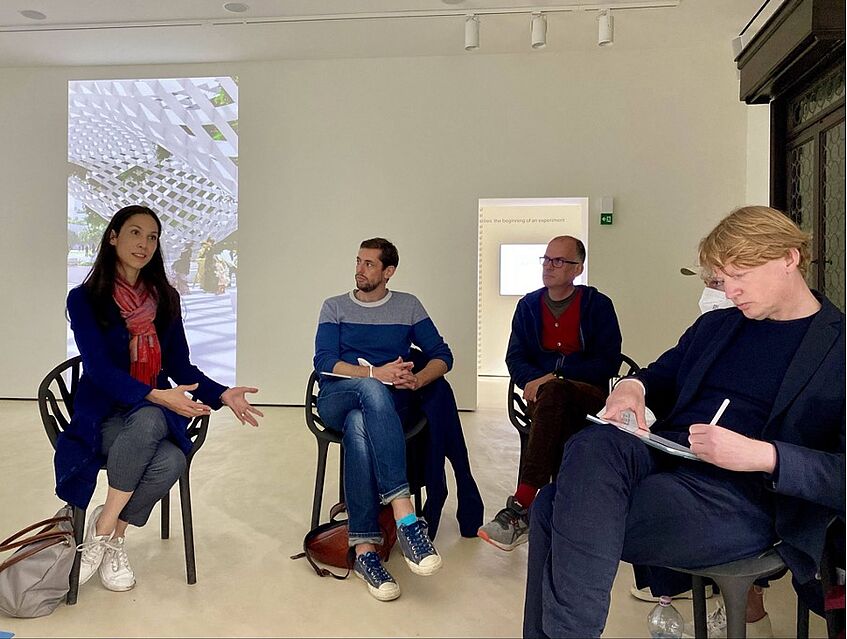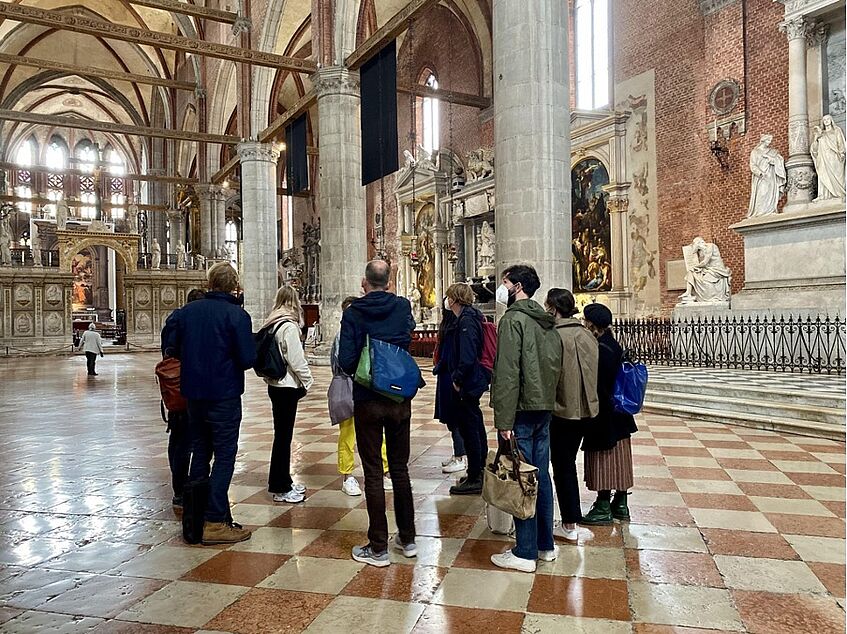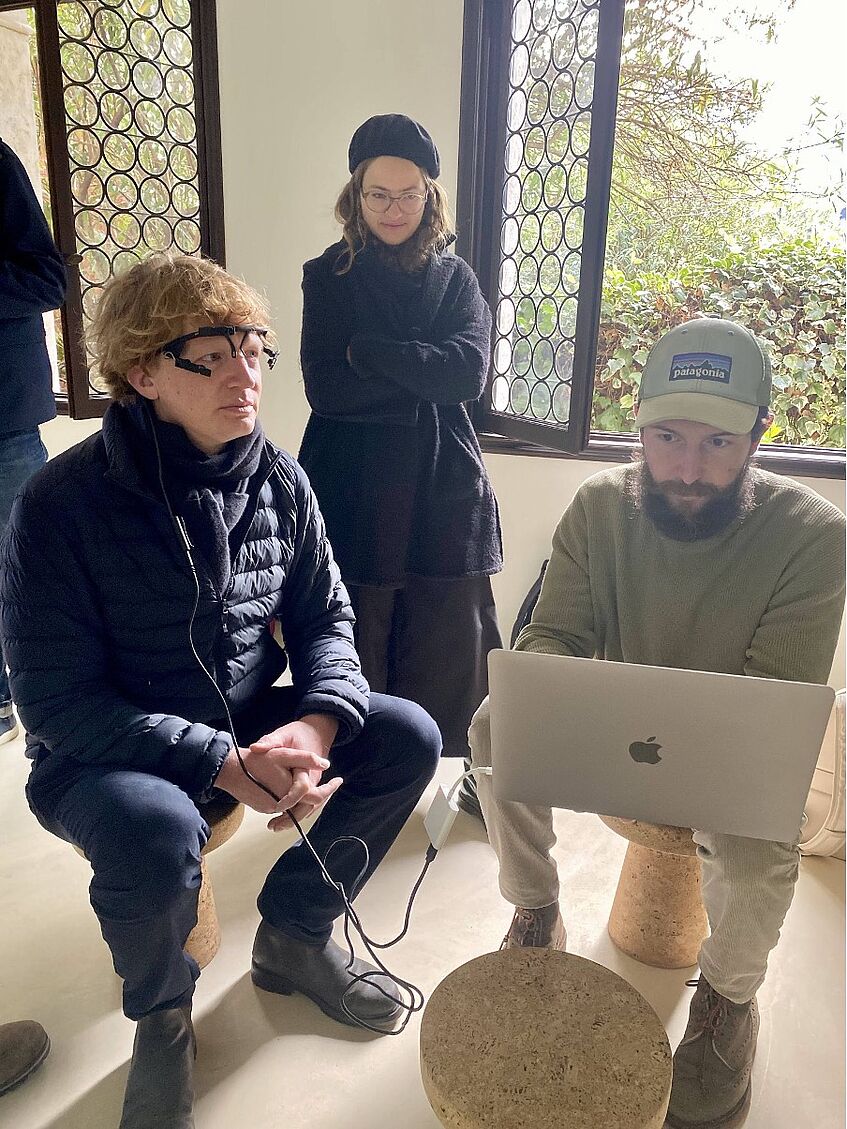ARTIS team in Venice
The intersection between art, architecture and transformations: Can art transform the way we think about the future of our city spaces?
“To appreciate a work of architecture is to experience it by moving around in it, using all one’s senses, including proprioception, one’s sense of one’s own body as it moves and orients.”—Robinson, 2012, p. 343
Imagine stepping off the cobbled stone street of Venice—away from the sound of the Grand Canal splashing against gondolas—into a calm white space that has an air of sanctity. As you enter a dim hallway and turn the corner you are faced with a room. Three of the walls are lit by narrow projected images of beautiful futuristic space. Shown is an organically reaching trellis, dripping with green ivy, covering a marketplace. Congregating together under the shade around rising boxes of plants are famous figures from art history. These figures, from paintings spanning thousands of years, give the space a sense of timelessness utopian. As you walk closer into the midst of the room, the images start to expand, seeping over the walls, exposing more to explore, more to see, more to inspire your thoughts.
As you are standing there visualizing how you might exist in such a space, you become aware of sounds; the overlapping sound of birds, wind in the trees, water and the low rumble of a cacophony of voices. As you turn to leave the room, suddenly, the lights go off.
Then a new image appears, this time the space is an intimate walkway on a winter night, the walls and figures are bathed in warm yellow light. The architecture curves organically, with stools inviting passersby to stop, rest, and take in the night. Could you imagine yourself sitting there, sharing a moment with a friend or even a stranger?
You think to yourself that these scenes could be scenarios of what the future of shared spaces could be. The images are filled with architecture that seems to be whispering of what the world could be, not just what it is now. These spaces seem to invite you to belong, to share and possibly open your mind up to new possibilities of how we can live together.
In October 2021, ARTIS went to Venice to engage an installation art and architecture project asking: What could future shared spaces look like?
The interactive art installation Mutualities allows visitors to experience 12 future city scenarios.
The installation reacts to the presence of people in the space by means of a Microsoft Kintec movement tracker. The scenes of cityscapes expand when a person enters the space showing new details for exploration. When moving to leave the space, the scene switches, and the visitor is invited to turn around and explore more. The project was a collateral event at the 17th International Architecture Exhibition Biennale Architettura 2021 Venice, Italy and will travel to Berlin in April 2022.
As part of our H2020 project we want to know how art can transform us. With Mutualities, we want to know how art installations transform how we think about shared spaces and how we live together now, and in the future.
Spaces can make us feel connected to ourselves, other people, and to the nature in the space and ideally initiate a sense of belonging. Spaces that are public should support what people want to do, support their behaviour, their identity, and their culture. Spaces can bring our sensations to the forefront and awareness of our body into appearance. The spaces that we spend our shared and public lives in are important, as they can inspire community, foster interaction or stop these collaborative attitudes in their tracks instilling anger, hostility, and individualism.
Have you ever heard about how architecture has power over how we interact in a space?
For example, with regards to wayfinding and mobility, architecture can guide us along certain paths to find our destination, which when done properly, allows free movement giving us security instead of stress or anxiety, feelings of being lost, confusion or claustrophobia.
Architecture can also impact how we feel, in our minds and bodies. With regards to health and wellbeing, studies have shown that we are affected by building facades: if the exterior of the building is complex, and interesting, it impacts people in a positive way (e.g., by decreasing stress levels); and impacts us negatively if it is simple and featureless (Lindal & Harting, 2013; Hollander et al., 2018; Ellard, 2020).
If you live in a large city, you may be familiar with a lot of concrete structures, narrow corridors next to lean, tall buildings and sharply bending street corners. Days could go by without seeing the horizon. Then, in your free time and holidays, you might seek to climb mountains or go to the sea in order to see the horizon, offering perspectives of vastness and distance. Thus, greenscapes and parks, and building design that allows for views and light are important design aspects for urban spaces to ensure a high quality of life, restoration and positive emotions like feeling present and calm also in larger cities. Urban spaces just like the images projected by Mutualities.
But what about images of spaces, what about projections of architecture? Is it possible to inspire the way we think about our spaces just from a brief interaction with an art installation about architecture?
As part of the research workshop “The Future of Neurourbanisms, we discussed these questions” and more. Included were ARTIS partners from Humboldt-Universität zu Berlin (Prof. Dr. Joerg Fingerhut) and Vienna (Asst. Prof. Matthew Pelowski, PhD Students Corinna Kühnapfel and MacKenzie Trupp), together with art historians Prof. Jörg Trempler and Isabel Groll, architect Prof. Matthias Ballestrem, Giacomo Bignardi (PhD Student at Max Planck School of Cognition) as well as student assistants Theresa Müller, Hannah Kruft. In partnership with the Interdisciplinary Forum Neurourbanism e.V. and the architecture group SpaceCouncil at the Mutualities exhibition.
Through discussion we came to focus on the role of the visitor choosing their preferred space. As this installation was constantly interacting with the bodies of visitors, quantifying and tabulating their movements to change the scenes one by one, we wonder about the role of the body. We wondered—What is the phenomenology with regards to the body when being in space? Can visitors make their opinions and preferences known with just their movements in the space?
These questions are still under investigation, involving a redesign of the exhibition space to allow for preferences of the body to become more clear.
We will continue in Berlin with these questions, stay tuned on our news page.
The End.
Further Reading
Allam, Z., & Dhunny, Z. A. (2019). On big data, artificial intelligence and smart cities. Cities, 89, 80–91. https://doi.org/10.1016/j.cities.2019.01.032
Crippen, M. (2016). Intuitive cities: Pre-reflective, aesthetic and political aspects of urban design. Journal of Aesthetics and Phenomenology, 3(2), 125–145. https://doi.org/10.1080/20539320.2016.1256067
Crippen, M., & Klement, V. (2020). Architectural Values, Political Affordances and Selective Permeability. Open Philosophy, 3(1), 462–477. https://doi.org/10.1515/opphil-2020-0112
Coburn, A., Vartanian, O., Kenett, Y. N., Nadal, M., Hartung, F., Hayn-Leichsenring, G., Navarrete, G., González-Mora, J. L., & Chatterjee, A. (2020). Psychological and neural responses to architectural interiors. Cortex: A Journal Devoted to the Study of the Nervous System and Behavior, 126, 217–241. https://doi.org/10.1016/j.cortex.2020.01.009
Ellard, C. (2020). Neuroscience, wellbeing, and urban design: Our universal attraction to vitality. Psychological Research on Urban Society, 3(1). https://doi.org/10.7454/proust.v3i1.81
González-Mora, J. L., & Chatterjee, A. (2020). Psychological and neural responses to architectural interiors. Cortex, 126, 217–241. https://doi.org/10.1016/j.cortex.2020.01.009
Dosen, A. S., & Ostwald, M. J. (2016). Evidence for prospect-refuge theory: A meta-analysis of the findings of environmental preference research. City, Territory and Architecture, 3(1), 4. https://doi.org/10.1186/s40410-016-0033-1
Hee, L. (2015). Can Dense Cities Really Be Liveable? In: S. Rassia & P. Pardalos (Eds.), Future City Architecture for Optimal Living. Springer Optimization and Its Applications, 102. Springer, Cham. https://doi.org/10.1007/978-3-319-15030-7_5
Hollander, J. B., Purdy, A., Wiley, A., Foster, V., Jacob, R. J. K., Taylor, H. A., & Brunyé, T. T. (2019). Seeing the city: Using eye-tracking technology to explore cognitive responses to the built environment. Journal of Urbanism: International Research on Placemaking and Urban Sustainability, 12(2), 156–171. https://doi.org/10.1080/17549175.2018.1531908
Jelić, A., & Stanicic, A. (2019). The memory in the bodily and architectural making: Reflections from embodied cognitive science. In J. Micieli-Voutsinas, & A. Person (Eds.), Affective Architectures: More-than-Representational Approaches to Heritage. Routledge - Taylor & Francis Group.
Jelić, A., Tieri, G., De Matteis, F., Babiloni, F., & Vecchiato, G. (2016). The enactive approach to architectural experience: A neurophysiological perspective on embodiment, motivation, and affordances. Frontiers in Psychology, 7. https://doi.org/10.3389/fpsyg.2016.00481
Lindal, P. J., & Hartig, T. (2013). Architectural variation, building height, and the restorative quality of urban residential streetscapes. Journal of Environmental Psychology, 33, 26–36. https://doi.org/10.1016/j.jenvp.2012.09.003
Mallgrave, H. F. (2020). Just What Can Architects Afford? IIn B. Condia (Ed.), Affordances and the Potential for Architecture. New Prairie Press.
Marcus, L. (2018). Overcoming the subject-object Dichotomy in urban modelling: Axial maps as geometric representations of affordances in the built environment. Frontiers in Psychology, 9, 449. https://doi.org/10.3389/fpsyg.2018.00449
Pelowski, M. (2021). Together in the dark?: Investigating the understanding and feeling of intended emotions between viewers and professional artists at the Venice Biennale. Psychology of Aesthetics Creativity and the Arts.
Robinson, J. (2012). On being moved by architecture. The Journal of Aesthetics and Art Criticism, 70, 337–353. https://doi.org/10.1111/j.1540-6245.2012.01526.x
Robinson, S. (2020). Articulating Affordances: Towards a New Theory of Design. In B. Condia (Ed.), Affordances and the Potential for Architecture. New Prairie Press.
Tinio, P. P. L., & Specker, E. (2020). Observation Method in Empirical Aesthetics. In M. Nadal & O. Vartanian (Eds.), The Oxford Handbook of Empirical Aesthetics. Oxford University Press. https://doi.org/10.1093/oxfordhb/9780198824350.013.10
Voda, A. I., & Radu, L.-D. (2019). How can artificial intelligence respond to smart cities challenges? https://www.sciencedirect.com/science/article/pii/B9780128166390000120
